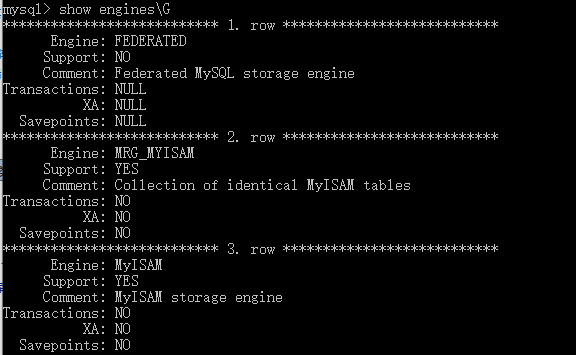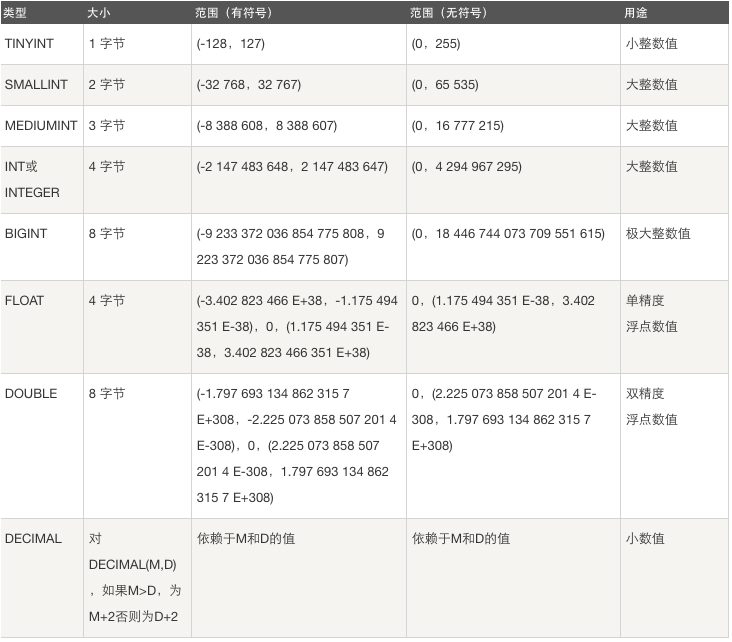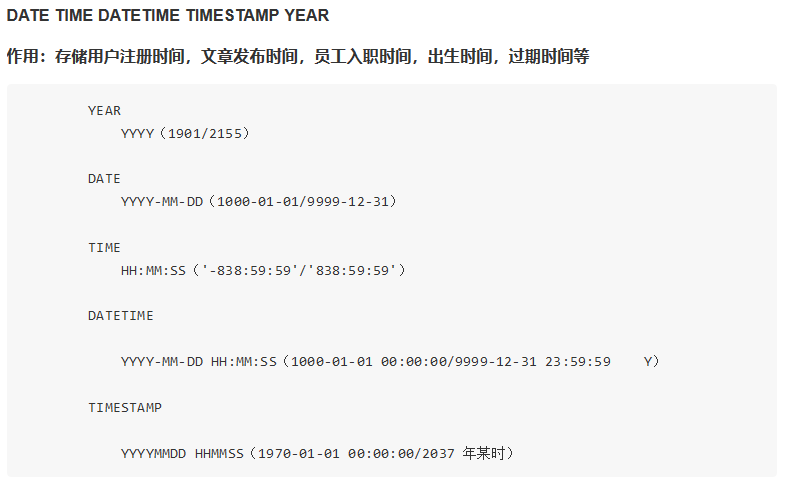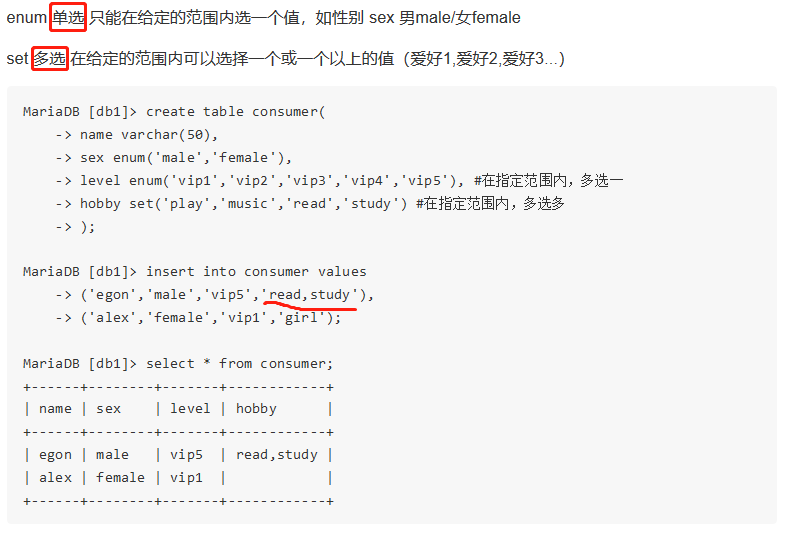MySQl的庫操作、表操作和資料操作
一、庫操作
1.1庫的增刪改查
(1)系統資料庫:

performance_schema:用來收集資料庫伺服器的效能引數,記錄處理查詢時發生的各種事件、鎖等現象
mysql:授權庫,主要儲存系統使用者的許可權資訊
test:MySQl資料庫系統自動建立的測試資料庫
(2)資料庫操作
建立:create database db1 charset utf8;
(資料庫命名規則:可以是字母、數字、下劃線等的組合,不能單獨使用數字,不能使用關鍵字例如create select等)
檢視:show databases; 或者 show create database db1;
選擇資料庫:use db1;
刪除:drop database db1;
修改:alter database db1 charset utf8;
二、表操作
2.1儲存引擎介紹
(1)類似於處理文字用txt型別,圖片用png,音樂用mp3型別,資料庫的表也有不同型別。表型別(儲存和操作此表的型別)又稱儲存引擎。MySQL資料庫提供了多種儲存引 擎。
(2)檢視MySQL支援的儲存引擎:
show engines\G #檢視所有支援的儲存引擎

show variables like 'storage_engine%'; #檢視正在使用的儲存引擎

(3)部分儲存引擎的簡單介紹:有InnoDB、MyISAM、NDB、Memory、Infobright、NTSE、BLACKHOLE等;其中InnoDB是MySQL預設和最常用的一個儲存引擎,具備高可用性、高效能以及高可擴充套件性。其他詳情點選:具體介紹
(4)使用儲存引擎
建表時指定
create table innodb_t1(id int,name char)engine=innodb;
show create table innodb_t1;
2.2表的增刪改查
(1)表介紹

(2)建立表 create table student(sid int(11),sname char(10),gender enum('男','女'),class_id int(11));
檢視庫下所有表 show tables;
往表中插入資料 insert into student values(10,'nuo','女',5);
(3)查看錶結構 desc student; 或者 show create table student\G; #檢視詳細表結構,可加\G

(4)修改表結構
(4.1)修改儲存引擎 alter table student engine=NDB;
(4.2)新增欄位 alter table student add age int not null;
(4.3)刪除欄位 alter table student drop age;
(4.4)修改欄位型別 alter table student modify age int(9) not null primary key;
(4.5)刪除主鍵 alter table student drop primary key;
(5)複製表
複製表結構+記錄 (key不會複製: 主鍵、外來鍵和索引)
mysql> create table new_service select * from service;
只複製表結構
mysql> select * from service where 1=2; //條件為假,查不到任何記錄
Empty set (0.00 sec)
mysql> create table new1_service select * from service where 1=2;
Query OK, 0 rows affected (0.00 sec)
Records: 0 Duplicates: 0 Warnings: 0
mysql> create table t4 like employees;
(6)刪除表 drop table student;
2.3資料型別
mysql常用資料型別有 數值型別 int , float 等、字串型別 char varchar 、日期型別 datatime等、列舉型別和集合型別
(1)數值型別

(2)日期型別



(3)字串型別 char 和 varchar

(char定長,varchar不定長,雖然varchar使用起來較為靈活,但是從整個系統的效能角度來說,char資料型別的處理速度更快,有時甚至可以超出varchar處理速度的 50%。因此,在選擇時,應該綜合考慮,以求達到最佳的平衡。)
(4)列舉型別和集合型別
列舉enum(),集合set();列舉單選,集合可多選;

2.4完整性約束
not null (非空)、default (預設)、primary key(主鍵,唯一)、foreign key(外來鍵)、unique(唯一)、auto_increment(自增,整數型別且為主鍵)
(1)設定唯一約束unique:

方法一: create table department1( id int, name varchar(20) unique, comment varchar(100) ); 方法二: create table department2( id int, name varchar(20), comment varchar(100), constraint uk_name unique(name) ); create table service( id int primary key auto_increment, name varchar(20), host varchar(15) not null, port int not null, unique(host,port) #聯合唯一 );View Code
(2)primary key

1 # 單列做主鍵 2 #方法一:not null+unique 3 create table department1( 4 id int not null unique, #主鍵 5 name varchar(20) not null unique, 6 comment varchar(100) 7 ); 8 9 #方法二:在某一個欄位後用primary key 10 create table department2( 11 id int primary key, #主鍵 12 name varchar(20), 13 comment varchar(100) 14 ); 15 16 #方法三:在所有欄位後單獨定義primary key 17 create table department3( 18 id int, 19 name varchar(20), 20 comment varchar(100), 21 constraint pk_name primary key(id); #建立主鍵併為其命名pk_name單列做主鍵

1 create table service( 2 ip varchar(15), 3 port char(5), 4 service_name varchar(10) not null, 5 primary key(ip,port) 6 );多列做主鍵
(3)foreign key

#表型別必須是innodb儲存引擎,且被關聯的欄位,即references指定的另外一個表的欄位,必須保證唯一 create table department( id int primary key, name varchar(20) not null )engine=innodb; #dpt_id外來鍵,關聯父表(department主鍵id),同步更新,同步刪除 create table employee( id int primary key, name varchar(20) not null, dpt_id int, constraint fk_name foreign key(dpt_id) references department(id) on delete cascade on update cascade )engine=innodb; #先往父表department中插入記錄 insert into department values (1,'歐德博愛技術有限事業部'), (2,'艾利克斯人力資源部'), (3,'銷售部'); #再往子表employee中插入記錄 insert into employee values (1,'egon',1), (2,'alex1',2), (3,'alex2',2), (4,'alex3',2), (5,'李坦克',3), (6,'劉飛機',3), (7,'張火箭',3), (8,'林子彈',3), (9,'加特林',3) ;View Code
(4)auto_increment

#不指定id,則自動增長 create table student( id int primary key auto_increment, name varchar(20), sex enum('male','female') default 'male' ); #應該用truncate清空表,比起delete一條一條地刪除記錄,truncate是直接清空表,在刪除大表時用它 mysql> truncate student; Query OK, 0 rows affected (0.01 sec) #設定步長 sqlserver:自增步長 基於表級別 create table t1( id int。。。 )engine=innodb,auto_increment=2 步長=2 default charset=utf8 mysql自增的步長: show session variables like 'auto_inc%'; #基於會話級別 set session auth_increment_increment=2 #修改會話級別的步長 #基於全域性級別的 set global auth_increment_increment=2 #修改全域性級別的步長(所有會話都生效) 清空表: delete from t1; #如果有自增id,新增的資料,仍然是以刪除前的最後一樣作為起始。 truncate table t1;資料量大,刪除速度比上一條快,且直接從零開始,View Code
三、資料操作
3.1資料的增刪改
假設已經建了一張表student
增加:insert into student values
(值1,值2,值3...),
(值1,值2,值3...),
(值1,值2,值3...);
刪除:delete from student
where condition
更新:update student set
欄位1=值1,
欄位2=值2,
where condition;
3.2單表查詢
一、單表查詢基本語法
select 欄位1,欄位2... from 表名
where 條件
group by field
having 篩選
order by field
limit 限制條數
二、關鍵字在執行中的優先順序
重點中的重點:關鍵字的執行優先順序
from
where
group by
having
select
distinct 去重
order by
limit
三、where約束
1、比較運算子:> < >= <= <> !=
2、between 80 and 100 值在10到20之間
3、in(80,90,100) 值是10或20或30
4、like 'egon%'
pattern可以是%或_,
%表示任意多字元
_表示一個字元
5、邏輯運算子:在多個條件直接可以使用邏輯運算子 and or not
四、group by 分組
如果我們用unique的欄位作為分組的依據,則每一條記錄自成一組,這種分組沒有意義 多條記錄之間的某個欄位值相同,該欄位通常用來作為分組的依據
五、聚合函式
#強調:聚合函式聚合的是組的內容,若是沒有分組,則預設一組
示例:
SELECT COUNT(*) FROM employee;
SELECT COUNT(*) FROM employee WHERE depart_id=1;
SELECT MAX(salary) FROM employee;
SELECT MIN(salary) FROM employee;
SELECT AVG(salary) FROM employee;
SELECT SUM(salary) FROM employee;
SELECT SUM(salary) FROM employee WHERE depart_id=3;
六、having
having和where不一樣的地方在於:
1、執行優先順序從高到低 where > group by > having
2、where 在group by 之前,因此where中可以有任意欄位,但是絕對不可以使用聚 合函式
3、having發生在分組group by之後,因此可以使用分組的欄位,無法直接取到其他 欄位,可以使用聚合函式。
七、order by 查詢排序
按單列排序:
SELECT * FROM employee ORDER BY salary;
SELECT * FROM employee ORDER BY salary ASC;
SELECT * FROM employee ORDER BY salary DESC;
按多列排序:先按照age排序,如果年紀相同,則按照薪資排序
SELECT * from employee
ORDER BY age, salary DESC;
八、使用正則表示式查詢
SELECT * FROM employee WHERE name REGEXP '^ale';
SELECT * FROM employee WHERE name REGEXP 'on$';
SELECT * FROM employee WHERE name REGEXP 'm{2}';
小結:
對字串匹配的方式
WHERE name = 'egon';
WHERE name LIKE 'yua%';
WHERE name REGEXP 'on$';
3.3多表查詢
多表連線查詢
符合條件連線查詢
子查詢
一、多表連線查詢
select 欄位
from 表一 inner|left|right join 表二
on 表一.欄位 = 表二.欄位;
(1)交叉連線:不適用任何匹配條件,生成笛卡爾積
假設我們已經生成employee,department兩張表
select * from employee,department;
(2) 內連線:只連線匹配的行
select employee.id department.name
from employee inner join department
on employee.id = department.id;
(3)外連線之左連線:優先顯示左表全部記錄
select employee.id department.name
from employee left join department
on employee.id = department.id;
(4)外連線之右連線:優先顯示右表全部記錄
right join ,其他參考左連線。
(5)全外連線 :顯示左右兩個表全部記錄
select * from employee left join department on employee.dep_id = department.id
union
select * from employee right join department on employee.dep_id = department.id;
二、符合條件連線查詢
#示例:以內連線的方式查詢employee和department表,並且以age欄位的升序方式顯示
select employee.id,employee.name,employee.age,department.name
from employee,department
where employee.dep_id = department.id and age > 25
order by age asc;
三、子查詢
# 子查詢是將一個查詢語句巢狀在另一個查詢語句中。
#2:內層查詢語句的查詢結果,可以為外層查詢語句提供查詢條件。
#3:子查詢中可以包含:IN、NOT IN、ANY、ALL、EXISTS 和 NOT EXISTS等關鍵字
#4:還可以包含比較運算子:= 、 !=、> 、<等

1 帶IN關鍵字的子查詢 #查詢平均年齡在25歲以上的部門名 select id,name from department where id in (select dep_id from employee group by dep_id having avg(age) > 25); #檢視技術部員工姓名 select name from employee where dep_id in (select id from department where name='技術'); #檢視不足1人的部門名 select name from department where id in (select dep_id from employee group by dep_id having count(id) <=1); 2 帶比較運算子的子查詢 #比較運算子:=、!=、>、>=、<、<=、<> #查詢大於所有人平均年齡的員工名與年齡 mysql> select name,age from emp where age > (select avg(age) from emp); +---------+------+ | name | age | +---------+------+ | alex | 48 | | wupeiqi | 38 | +---------+------+ rows in set (0.00 sec) #查詢大於部門內平均年齡的員工名、年齡 select t1.name,t1.age from emp t1 inner join (select dep_id,avg(age) avg_age from emp group by dep_id) t2 on t1.dep_id = t2.dep_id where t1.age > t2.avg_age; 3 帶EXISTS關鍵字的子查詢 EXISTS關字鍵字表示存在。在使用EXISTS關鍵字時,內層查詢語句不返回查詢的記錄。 而是返回一個真假值。True或False 當返回True時,外層查詢語句將進行查詢;當返回值為False時,外層查詢語句不進行查詢 #department表中存在dept_id=203,Ture mysql> select * from employee -> where exists -> (select id from department where id=200); +----+------------+--------+------+--------+ | id | name | sex | age | dep_id | +----+------------+--------+------+--------+ | 1 | egon | male | 18 | 200 | | 2 | alex | female | 48 | 201 | | 3 | wupeiqi | male | 38 | 201 | | 4 | yuanhao | female | 28 | 202 | | 5 | liwenzhou | male | 18 | 200 | | 6 | jingliyang | female | 18 | 204 | +----+------------+--------+------+--------+ #department表中存在dept_id=205,False mysql> select * from employee -> where exists -> (select id from department where id=204); Empty set (0.00 sec)View Code

